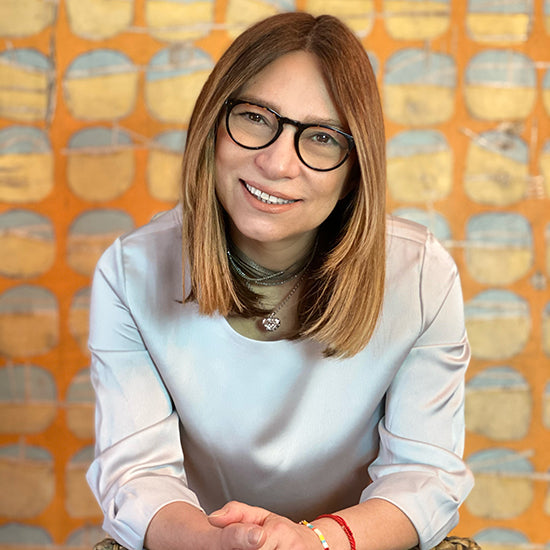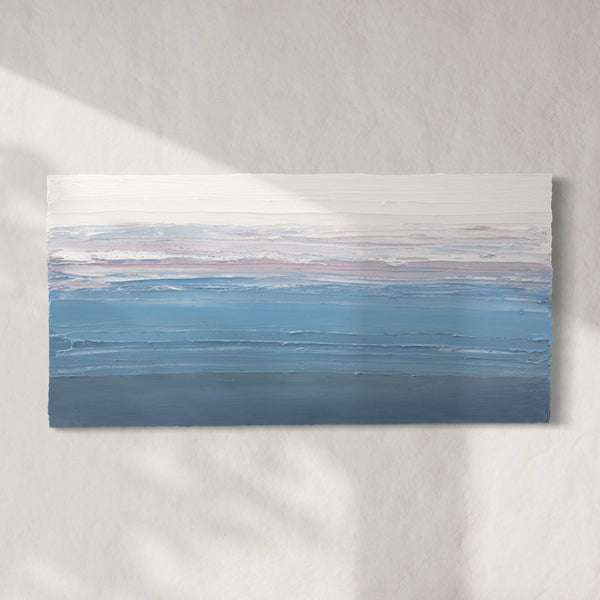Sofie Swann is an abstract artist based in Connecticut. Born and raised in Tehran, Iran, she was forced to leave her home country and find refuge in the US at a young age, an experience which deeply informs her work today. After several years of testing different art styles and media, and moving around, Sofie found her voice in the abstract paintings she has grown into, renditions of past experiences and her own emotive response as she creates them. We spoke with Sofie about her process, what (and who) inspires her, and how she developed her trademark style.
Our Interview with Sofie Swann
Where are you from originally and where are you located now?
I was born in Tehran, Iran and immigrated to the US when I was a teenager. It was during the beginnings of a revolution, a time of true chaos, loss and distress. Since then my life has been somewhat nomadic. I first lived in California, then moved to the east coast and later settled in Boston for many years before moving to Paris, France. I’ve since moved back to the U.S. and settled in Connecticut.
How would you describe your work?
I’m an abstract painter. My paintings are primarily composed of repetitive elements that create a sense of rhythm or movement. A curator recently tied my work to the Minimalist and Pattern and Decoration (P&D) movement of the 1970s, which, while not a conscious choice, is actually a fitting description.
What is your artistic process like (i.e. walk us through how you create a piece or series)?
All my paintings start with an experience, real or imagined, that triggers an emotion. It is from that emotional place that I gravitate toward a particular palette. Images and memories of the past, and the chaos of my earlier life intrude my daily thoughts often, as do my other life experiences. Nowhere is this more evident than in the earlier stages of my paintings, where I lay down marks and layers with chaotic, even frenzied, emotion in an effort get the thoughts and conversations swirling in my head down on the canvas. Eventually, as with any story that must come to an end, the conversation begins to subside. Now I must bring order to the chaos. At this stage, I give life to the marks that tell the story, hence the repetition, letting other marks remain hidden even though they formed an important part of the conversation. I often give life to what others may consider mistakes. I also hide my trademark “house” somewhere in each painting—that’s my signature. Finding a place that feels like home is very important to me because I lost that at such a young age.
I should add that since my process is emotion-based, I work on one canvas at time. Moving back and forth between paintings disrupts the story that is unfolding on canvas, resulting in work that feels disrupted or disjointed.

What is your favorite part of your creative process?
With every painting there is that moment when a switch is flipped, where I feel one hundred percent aligned with my subconscious and I’m “in” the painting. I’m so immersed that nothing I’m doing is intentional. This usually happens after the beginning and just before the end of the painting. The initial layers and markings are on the canvas but now the story needs to unfold before reaching the finale.
Is there ever a particularly challenging part of the process? How do you overcome challenges as you create?
I find every painting challenging, whether large or small. One would think that the process would be rote by now but it isn’t for me. Part of it has to do with the fact that I intentionally don’t sketch. This helps preserve my spontaneity.
What influences you most?
My thoughts and emotions. That’s where it all starts. I don’t paint what I see. I paint what I feel.
How did you get started with painting as a medium?
For me, it was a long process. I was always an art lover but it took quite some time for me to find my voice. I took courses at the School of the Museum of Fine Arts in Boston and dabbled in a number of styles - landscapes, portraits - but never felt comfortable with any of it. The timing just wasn’t right. It wasn’t until after I returned from France that I found that my voice really took shape internally and when I started translating that onto canvas, that’s when I felt I was painting what felt true to me. I always say art isn’t something you choose, it chooses you. And it took years for art to choose me.
You often use Persian tea in your paintings. What made you choose that as a medium to accompany paint? At what point does it get used during the process?
First and foremost, it’s largely symbolic. I’ve struggled with issues of cultural bereavement and identity for the better part of my life. I never returned to my homeland. My memories of my first home are purely nostalgic. The realization that what I held on to as a reference for my identity had changed so drastically it had become unrecognizable, triggered a significant sense of loss - a feeling of emotional homelessness, so to speak. I was fortunate enough to have left at a young enough age where acculturation was not insurmountable. Assimilation came easier and eventually, the sense of loss and alienation gave way to a new sentiment of belonging. So using Persian tea in my work is my subtle way of holding onto my roots and merging that identity with my new self. I also happen to love the subtle sepia tone of Persian tea. I use tea in various stages of my process. Sometimes I use it at the beginning, where you may see hints of it in the final painting, other times closer to the end, where you can see it more clearly.

The colors and color combinations you select for your paintings are really unique. How do you choose colors for a painting?
The choice of colors comes from an emotional place. I reach for colors that remind me most of the story I want to tell. It’s also a matter of personal aesthetic. I gravitate towards colors that are complementary. I don’t like to see too much happening in a painting in terms of color variety. I prefer to see one or two predominant colors with subtle variations.
You’ve said that your artwork is tied to your personal history and experiences. What is your hope for a viewer as they look at a painting you’ve created?
Convention says that to be a good painter, one must be a good observer. I am not so much an observer as I am an absorber. My paintings relate to vivid memories of my life experiences and my emotional response to them. Sometimes these experiences are imagined, like things pulled from dreams or a conversation I wish I had with someone. So each one of my paintings is a window to some part of my life. In this way, my paintings are autobiographical, telling my life story on canvas. I read an article about me where the writer said I translate my memories in code. I think that was a pretty good description.
There’s no possible way for a viewer to glean the story behind each painting, (other than the title, perhaps, which may give some indication of what the painting is about), because the representational elements are not that obvious. My hope for viewers is that they find their own story, something in the colors or the elements or the movement that resonates. Collectors who have purchased my work often tell me that each time they look at my work they see something different.
Are there any artists who have inspired you or your work?
There are many artists who have inspired me over the years but I’ve always been drawn to the work of expressionist and abstract expressionist artists, particularly Van Gogh, de Kooning, Franz Kline, Rothko, Twombly. Monet is an absolute favorite even though he was an Impressionist; the first time I stood in front of some of his Water Lilies paintings they literally took my breath away. And then there are Louise Bourgeois and Yayoi Kusama who, in my view, are in a category all by themselves. I feel very fortunate because I lived in Paris for a number of years and there was always something interesting happening in the museums and galleries so I had the opportunity to be in the presence of many of these works and many other interesting and unique artists. And of course now, with social media platforms such as Instagram, I think we’re all fortunate to be exposed to all the talent that’s out there and draw inspiration from them.

From your first painting to those you create now, how would you say you’ve grown as an artist?
I was still finding my identity and voice as an artist in my earlier works. That’s why my first paintings weren’t a cohesive body of work as I was still exploring how to produce a genuine expression of my inner self on canvas. After much personal exploration, I found my voice and artistic rhythm.
Has the pandemic affected your creative process at all? If so, in what way(s)?
I definitely felt a shift. The pandemic chaos, the political chaos, the deep divisions in society—I just wanted to get away from all the noise. I found myself instinctively reaching for colors that corresponded to my yearning for calm, silence and purity. This was in stark contrast to my work a year ago where it was all about bolder, more vibrant colors. I’m also weirdly obsessed with gesso right now as a medium. Something about its chalky quality feels so pure to me. So I’m using it more and more liberally, either by itself or mixed with other colors.
What’s next for your work? Where do you see it going?
I’ll continue to tell my stories on canvas, exploring different ways to use simplistic forms to bring those stories to life. I’ve been wanting to translate my work to sculpture but I’m not quite there emotionally. It’s simmering though, starting to take shape but I’m not pushing it. When the time is right, I’m sure it’ll start pouring out.
In 5 words or less, what is your goal as an artist?
Grow, experiment, inspire, engage, challenge.
What do you do in your free time (aside from art)?
More than anything, I appreciate every moment I spend with family (and my dog!). This past year has given more meaning to these simple pleasures than any other time in recent memory.
Sofie's solo exhibition, Finding Home, is on view at Sorelle March 4 - March 26, 2021. Read more about the show, or view all art by Sofie, including original paintings, as well as limited and open edition prints, on her artist page. You can also watch highlights of our Live Q&A on our event page (scroll to the bottom to watch!).




0 comments
Post a comment